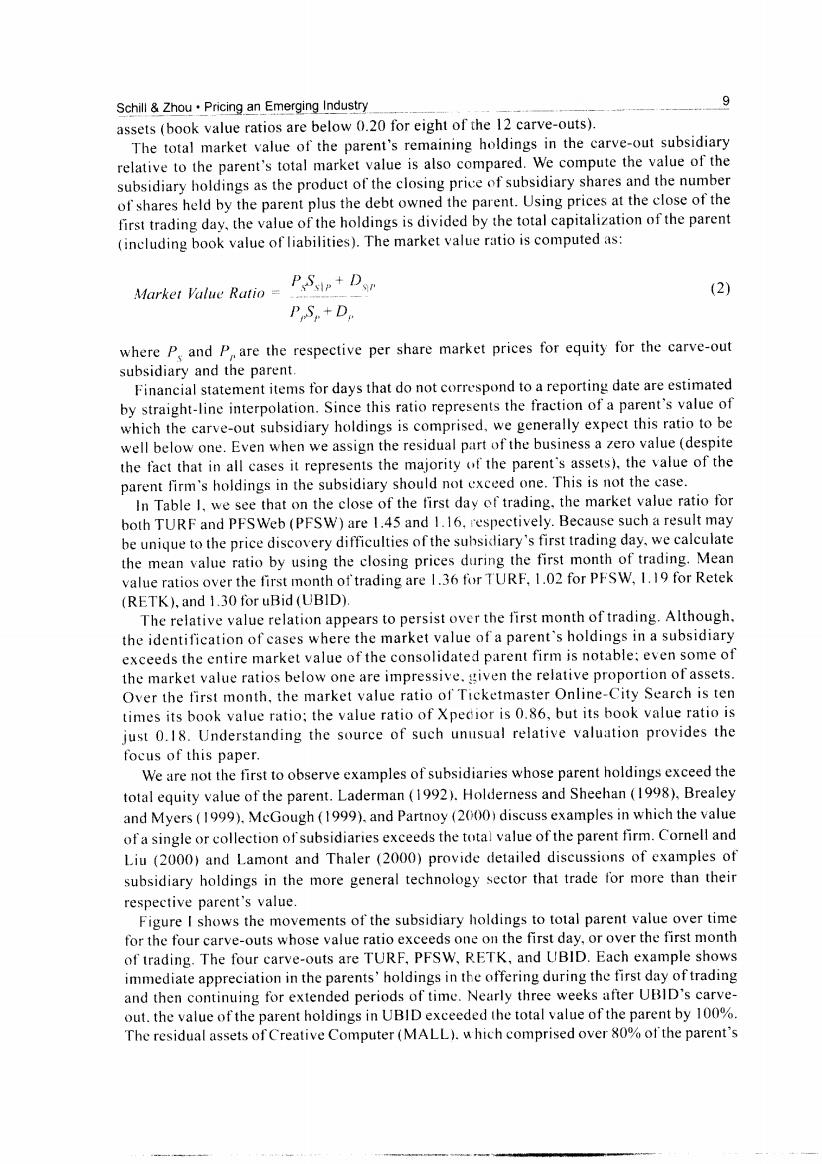正在加载图片...

Schill Zhou.Pricing an Emerging Industry assets (book value ratios are below 0.20 for eight of the 12 carve-outs). The total market value of the parent's remaining holdings in the carve-out subsidiary relative to the parent's total market value is also compared.We compute the value of the subsidiary holdings as the product of the closing price of subsidiary shares and the number of shares held by the parent plus the debt owned the parent.Using prices at the close of the first trading day,the value of the holdings is divided by the total capitalization of the parent (including book value of liabilities).The market value ratio is computed as: Market Value Ratio PSsip+Dsr (2) P S.+D where P and P are the respective per share market prices for equity for the carve-out subsidiary and the parent. Financial statement items for days that do not correspond to a reporting date are estimated by straight-line interpolation.Since this ratio represents the fraction of a parent's value of which the carve-out subsidiary holdings is comprised,we generally expect this ratio to be well below one.Even when we assign the residual part of the business a zero value(despite the fact that in all cases it represents the majority of the parent's assets),the value of the parent firm's holdings in the subsidiary should not cxceed one.This is not the case. In Table I,we see that on the close of the first day of trading,the market value ratio for both TURF and PFSWeb(PFSW)are 1.45 and 1.16.respectively.Because such a result may be unique to the price discovery difficulties of the subsidiary's first trading day,we calculate the mean value ratio by using the closing prices during the first month of trading.Mean value ratios over the first month of'trading are 1.36 for TURF,1.02 for PFSW,1.19 for Retek (RETK),and 1.30 for uBid (UBID). The relative value relation appears to persist over the first month of trading.Although. the identification of cases where the market value of a parent's holdings in a subsidiary exceeds the entire market value of the consolidated parent firm is notable;even some of the market value ratios below one are impressive.given the relative proportion of assets. Over the first month,the market value ratio of Ticketmaster Online-City Search is ten times its book value ratio;the value ratio of Xpedior is 0.86,but its book value ratio is just 0.18.Understanding the source of such unusual relative valuation provides the focus of this paper. We are not the first to observe examples of subsidiaries whose parent holdings exceed the total equity value of the parent.Laderman(1992).Holderness and Sheehan(1998),Brealey and Myers (1999).McGough(1999).and Partnoy (2000)discuss examples in which the value of a single or collection of subsidiaries exceeds the total value of the parent firm.Cornell and Liu (2000)and Lamont and Thaler (2000)provide detailed discussions of examples of subsidiary holdings in the more general technology sector that trade for more than their respective parent's value. Figure I shows the movements of the subsidiary holdings to total parent value over time for the four carve-outs whose value ratio exceeds one on the first day,or over the first month of trading.The four carve-outs are TURF,PFSW,RETK,and UBID.Each example shows immediate appreciation in the parents'holdings in the offering during the first day of trading and then continuing for extended periods of time.Nearly three weeks after UBID's carve- out.the value of the parent holdings in UBID exceeded the total value of the parent by 100%. The residual assets of Creative Computer(MALL).which comprised over 80%of the parent's